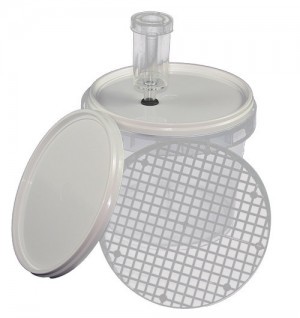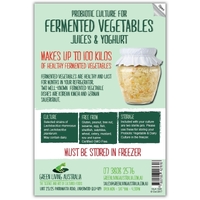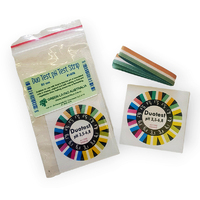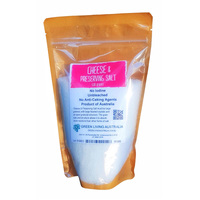Fermenting Vegetables Recipes
These directions are typical of what can be found on the internet and in many good books about cultured veggies.
When using 'wild fermentation' the directions will call for larger amounts of salt to be added to the vegetable mixture to limit the growth of pathogenic bacteria and enhance the growth of the probiotic lactic bacteria. The use of our Probiotic Vegetable and Dairy Culture reduces the amount of salt required, as this culture is what is known as a protective culture, which inhibits unwanted bacteria, yeasts and moulds.
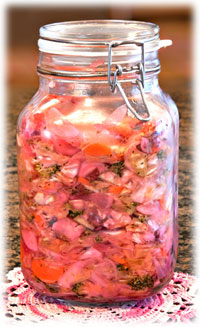 |
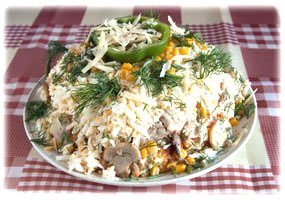 |
Why You Should Be Eating Cultured Vegetables.
Fermentation is a culinary technique prized by humans for thousands of years. During the process of lactic fermentation, lactic acid already present in a given food is utilized to predigest the food into a simpler substance. This process involves creating an environment that is hospitable to beneficial bacteria, yet inhospitable to harmful microorganisms. The food to be fermented is prepared; placed in a jar, a crock, or another suitable container; and sits virtually undisturbed for hours, days, weeks, even months while the lactic acid does its work. The result is a tangy delicacy with a distinct flavour. Two well-known fermented vegetable dishes are Korean kimchi and German sauerkraut.
Equipment
- Sealable fermentation jar, pail or system.
- Large bowl
- Cutting board and a sharp knife
- Blender and/or food processor (optional)
Ingredients
- A mixture of veggies: cabbages, carrots, cauliflower, etc.
- Fresh herbs, garlic, ginger, seeds like fennel or caraway, pepper, etc. (optional)
- Kimchi paste (optional)
- The required dose of Probiotic Vegetable Culture.
- Non-iodised salt, i.e. preserving salt or cooking salt (optional)
- One teaspoon of liquid Calcium Chloride per kilogram of vegetables (optional for crispness)
- Filtered or bottled non-chlorinated water
Directions
- Wash well and chop finely or shred/process a mixture of vegetables of your choice.
- Mix together in a large bowl with one to one and a half teaspoons of salt per kilo of vegetables. If using herbs, spices and/or kimchi paste, mix in now.
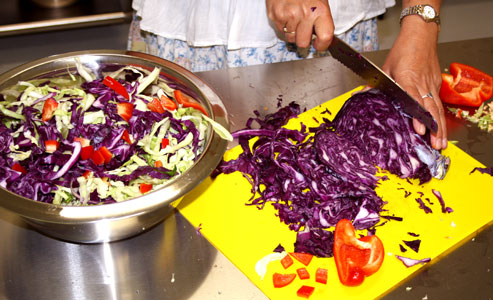
- Mix the Starter Culture into half a cup of filtered or bottled water and let sit for a few minutes.
- Pack the vegetables into your sterilised glass container(s), leaving an inch or two at the top, or into a sterilised crock or pail, leaving room for the stones or grill.
Fermentation Pail; If using a GLA Fermentation Pail, add the culture water and calcium chloride (optional for crispness). to the veggies and top up with filtered or bottled water. Ensure the grill is holding the veggies under the water. Place the airlock into the lid and pop into place. Half fill the airlock and put the lid on the airlock.
Fermentation Crock; If using a stoneware crock, add the culture water and calcium chloride (optional for crispness) to the veggies and top up with filtered or bottled water. Ensure the stone/s are well covered, close and fill the ‘moat’ with water or olive oil.
I have found it best to cover the stones with about 50 mm of water. If any pieces of vegetable escape from under the stone and grow a little bit of 'fuzz' on them they can then be easily scooped out, prior to harvesting your veggies.
Glass Jars; If using jars, share the culture water and calcium chloride (optional for crispness) evenly between the jars, then top up with filtered or bottled water to make sure there is enough liquid to reach the top of the vegetables when they are pressed down. Then stuff a couple of rolled-up cabbage leaves at the top of the container and seal the container.
The jar will need to be opened every day or so to allow the gas build-up to escape. Fermentation crocks and pails do this automatically.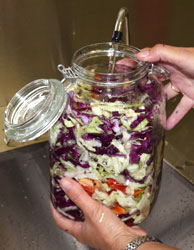
The only drawback to this system is that opening the jars every few days may allow yeast spores to get into the jar and contaminate your cultured vegetables
- Check the taste after a few days, by which time they should start tasting vinegary.
- When they reach the desired flavour, refrigerate to slow the fermentation process. Your fermented vegetables should now be at a pH of 4.4 or lower. Use pH test paper to test if unsure.
- Eat as a side dish with your meals, in salads, sandwiches or wraps, or as a topping to other foods. The cultured vegetables should be eaten raw, to preserve the beneficial enzymes and bacteria.
Making Fermented or Cultured Vegetables.
See Green Living Australia’s vegetable fermentation systems and see a batch of fermented veggies packed and started.

